INTRODUCTION
The hard parts of an animal body present inside or outside the body collectively form the skeletal system.
Skeleton serves as the reservoir of many minerals, like calcium and phosphate.
The marrow of the long bones is the site for the haemopoiesis, i.e., for mation of blood cells
(RBC, WBC).
The skeleton plays a vital role in movement and locomotion.
Human skeleton consists of 206 pieces of bones.
In infants 306 bones are present. The act of moving from place to place is known as locomotion.
It involves the movement of the whole body, as in walking, running, swimming or flying. Movement
is the change in position of only a part of the body, as movement of stem towards light in plants.
Why animals need locomotion :
1. Locomotion enables animals to move from an unfavourable place or environment to a safe place.
2. It helps them to escape from their enemies and predators.
3. It hepls animals to find their partners for reproduction, and to move to safe place for laying
eggs or rearing of the young ones.
Girdle bones : These provide a connection between the axial skeleton and limbs. The two
girdles are named as pectoral and pelvic girdles, respectively.
JOINTS
Joints are the place of articulation between two or more bones or between a bone and a cartilage.
Due to the presence of a number of joints, the movement of the different body parts and the whole body is possible.
Types of Joints :
(i) Fixed or immovable or fibrous joint : There is no space between the bones. The attached bones are tightly held with the help of while fibrous connective tissure
e.g. Between bones of vertebrae and pelvic girdle.
(ii) Slightly movable or cartilaginous joint : It is an articulation between the bones that allows very little movement e.g. Between bones of vertebrae and pelvic girdle.
(iii) Movable joint or synovial joint : It is a joint which allows the movement of articulating bones such that they can move extensively upon each other. The space
between bones is called synovial cavity. This cavity remains filled with a viscous and slippery synovial fluid.
These are of following types :
(A) Ball & socket joint : One bone forms a ball like head that fits into a socket formed in the other bone. The bone with head can move nearly in all the directions.
e.g. Shoulder joint, hip joint.
(B) Hinge joint : This joint allows movements in one plane only. e.g. Elbow joint & knee joint.
(C) Pivot joint : This joint allows only a rotatory movement of one bone on the other stationary bone. e.g. Atlas and axis vertebrae.
(D) Angular joint / Ellipsoid / condyloid joint : This allows movement in two directions - side to side and back & forth. e.g. Wrist joint.
(E) Gliding joint : This joint permits sliding movement of two bones over each other, e.g. Carpal in wrist and tarsals in ankle.
MOVEMENT IN DIFFERENT ANIMALS
(a) Movement in Amoeba : Amoeba is an unicellular organism which can move with pseudopodia (false feet).
(b) Movement in Earthworm : Earthworm doesn’t have bones. It has muscle which help in locomotion with setae (hook like chitinous structure.)
During movement it first extends the front part of the body keeping the rear portion fixed to the ground with the help of setae.
Then it fixes the front end and release the rear end.It then shortens the body and pulls the rear end forward.By repeating such
expansions and contraction it can move through soil.
(c) Movement in Snail : Snail is a molluscan which doesn’t has bones but has muscles.A shell is present as outer skeleton During movement a thick muscular
foot comes out of the shell’s opening.By the contraction & expansion of the foot muscle it can do slow movement at a substratum.
(d) Movement in Cockroach : Cockroach is an arthropod which has jointed appendages. It has three pair of legs and two pairs of wings attached to the thorax.
The cockroaches have distinct muscles.
(i) walking muscles - muscle attach to legs.
(ii) flying muscles - thorax muscle attach to wings.
(e) Movement in Fish : Fishes are aquatic animals. Head and tail of the fish are smaller than the middle portion of the body.
This body shape is called stream lined which is helpful to reduce friction during movement. It has caudal, dorsal (impaired), pectoral, pelvic (paired) fins.
Fishes have skeletal & muscular system both. During swimming, muscles make the front part of the body curve to one side and the tail part swings
towards the opposite side. Then quickly the body and tail curve to the other side.This makes a jerk and pushes the body forward. A series of jerks
make the fish swim ahead. This is helped by fins of the tail.
Thus paired fins help in the maintaining balance of body during swimming while impaired provide jerk.
Fish lacking bones : In sharks, skeleton is made entirely of cartilage.
MUSCLE BONE RELATION
Movement of organs and different parts of the body are brought about by the contraction of skeletal muscles inserted into the articulating bones.
Ligaments : flexible connective tissue bands called ligaments stabilize the joints by holding the articulating bones together.
Tendons (lnsertion of skeletal muscles) : The skeletal muscles are attached to the bones by tendons. Tendons
are formed of white fibrous connective tissue.
Muscle movement : Muscle are made up of two kind of contractile proteins - Actin & Myosin, which are helpful in locomotion.
Muscle work in pairs when one of them contracts the other muscle of the pair relaxes. To move the bone in
the opposite direction, the relaxed muscle contracts to pull the bone towards its original position while the
first relaxes. A muscle can only pull. It can’t push. Thus, two muscles have to work together to move a bone.
(f) Movement in Snake : Snakes are reptiles which can do creeping movement with the help of skeletal and muscular system. Muscles
are interconnected to long backbone, ribs and skin. The snakes body curve into many loops. Each loop gives
it a forward push by pressing against the ground. These movements occur rapidly in its body that show a very fast movement.
(g) Movement in Birds : Birds (Aves) can fly in the air and walk on the ground and some birds like duck can swim in water also.In birds skeletal (with
hollow bones) and muscular system are present. Forelimbs are modified into wings. Shoulder bones are strong and breast bones
are modified to hold muscles of flight which are used to move the wings up and down.While bones of hind limbs are typical for
walking and perching.
OBJECTIVE TYPE
1. Number of bones present in vertebral column in human
(A) 26 (B) 36 (C) 34 (D) 29
2. Joint which allows movements only in one plane is known as :
(A) Ball & socket joint (B) Gliding joint
(C) Pivot joint (D) Hinge joint
3. Tissue which connect bone to muscle is known as
(A) Muscle (B) Ligament (C) Tendon (D) Neuron
4. Appendicular skeleton is made up of
(A) Girdles (B) Hind limb bones (C) Fore limb bones (D) All
5. Fixed or immovable joints is present in
(A) vertebrae (B) shoulder joint (C) skull bones (D) knee joint
6. Which can do skeletal & muscular movement both ?
(A) Earthworm (B) Snail (C) Fish (D) Cockroach
7. Total number of ribs in human body
(A) 10 pairs (B) 11 pairs (C) 12 pairs (D) 13 pairs
8. Wings are modified
(A) Limbs (B) Forelimbs (C) Hind limbs (D) None of these
9. Pectoral girdle is present in
(A) Hand (B) Shoulder (C) waist (D) Leg
10. Which of the following type of joint is present in our neck ?
(A) Ball & Socket (B) Hinge (C) Fixed (D) Pivot
SUBJECTIVE TYPE
1. Define movement.
2. Name various parts of axial skeleton.
3. What are joints ? Describe the types of joints.
4. Describe the movement in birds and how it is differ from insect flight.
5. How can fish swim in water ?
ANSWER KEY
1. A 2. D 3. C 4. D 5. C 6. C 7. C 8. B 9. B 10. D
MULTIPLE CHOICE QUESTIONS
1. Which of the following parts of our body help us in movement?
(i) Bones (ii) Skin (iii) Muscles (iv) Organs
Choose the correct answer from the option below.
(a) (i) and (iii) (b) (ii) and (iv)
(c) (i) and (iv) (d) (iii) and (ii)
2. Which of the following joints is immovable?
(a) Shoulder and arm (b) Knee and joint
(c) Upper jaw and skull (d) Lower jaw and upper jaw
3. Which of the following organisms does not have both muscles and skeleton for movement?
(a) dog (b) snail (c) earthworm (d) human being
4. Underwater divers wear fin-like flippers on their feet to
(a) swim easily in water. (b) look like a fish.
(c) walk on water surface. (d) walk over the bottom of the sea (sea bed).
5. Snail moves with the help of its
(a) shell (b) bone (c) muscular foot (d) whole body
6. How many muscles work together to move a bone?
(a) One (b) Two (c) Three (d) Four
VERY SHORT ANSWER QUESTIONS
7. Name the type of joint of your hand which help you to grasp a badminton racquet.
8. What would have happened if our backbone was made of one single bone?
9. Provide one word answers to the statements given below.
1. Joint which allows movement in all directions.
2. Hard structure that forms the skeleton.
3. Part of the body with a fixed joint.
4. Help in the movement of body by contraction and relaxation.
5. Bones that join with chest bone at one end and to the backbone at the other end.
6. Framework of bones which gives shape to our body.
7. Bones which enclose the organs of our body that lie below the abdomen.
8. Joint where our neck joins the head.
9. Part of the skeleton that forms the earlobe.
10. Write the type of joint which is used for each of the following movements:
(a) A cricket bowler bowls the ball.
(b) A girl moves her head in right and left direction.
(c) A person lifts weights to build up his biceps.
SHORT ANSWER QUESTIONS
11. Match the name of the animals given in Column I with its body parts used for movement given in Column II.
Column I Column II
(a) Humanbeing (i) Fins
(b) Cow (ii) Wings
(c) Snake (iii) Legs
(d) Engle (iv) Whole Body
(e) Fish (v) Limbs
12. Given below is a list of different types of movements in animals.
Running, Jumping, Walking, Slithering,
Crawling, Flying, Swimming, Creeping
Write the types of movements seen in each animal.
(a) Duck (b) Horse
(c) Kangaroo (d) Snail
(e) Snake (f) Fish
(g) Human beings (h) Cockroach
13. Boojho fell off a tree and hurt his ankle. On examination the doctor confirmed that the ankle was fractured. How was it detected?
14. Bones are hard structures and cannot be bent. But, we can still bend our elbow, knee, etc. How is this possible?
15. Which type of movement would have been possible if
(a) our elbow had a fixed joint.
(b) we were to have a ball and socket joint between our neck and head.
16. Earthworms are known as ‘farmer’s friends’. Why?
LONG ANSWER QUESTIONS
17. (a) Unscramble the jumbled words and write them in the blank spaces provided.
(i) neosb ................ (v) arctigeal ................
(ii) tnemevom ................ (vi) epahs ................
(iii) iontcaronct ................ (vii) sangro inerlan ................
(iv) lsecsum ................ (viii) laxaeriont ................
(b) Read the following paragraph and fill in the blanks using the words you unscrambled.
______(a)______ and ______
(b)______ form the skeleton of the human body.
They provide the framework, give ______(c)______ to the body and help in______(d)______ They protect the ______(e)______ The bones are moved by alternate ______(f)______ and ______(g)______ of two sets of ______(h)______attached to them.
18. How is the skeleton of a bird well-suited for flying?
19. In Fig. 3.2 there are two snakes of the same size slithering on sand. Can you identify which of them would move faster and why?
Fig. 3.2
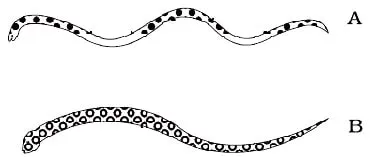
Study Material © 2023 All Rights Reserved.
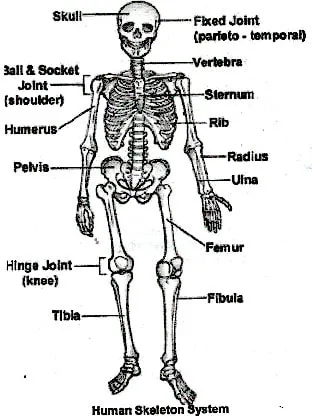

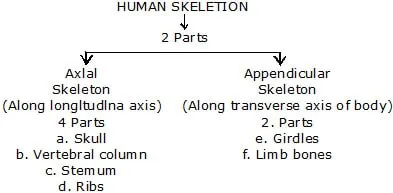
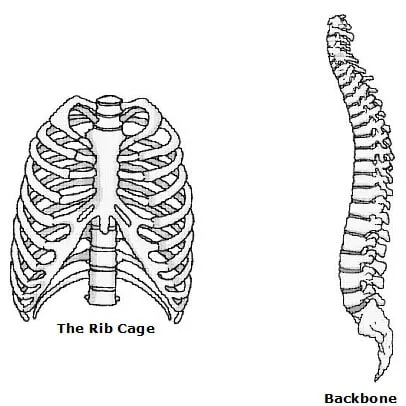


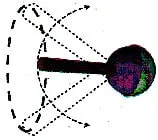
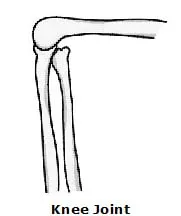
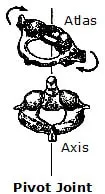
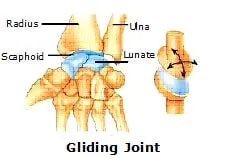

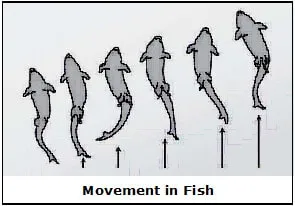



Ruby yadav
very useful content.. keep posting blog like this.. it is very helpful for the students like us to get correct information